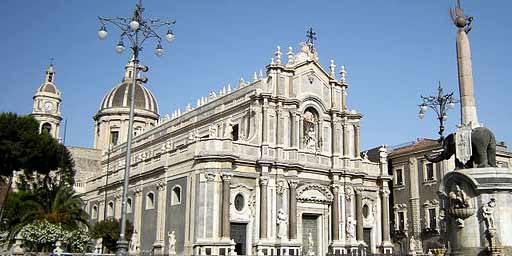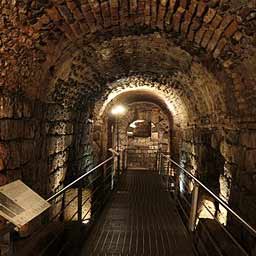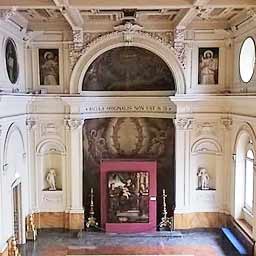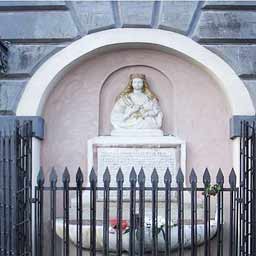Piazza Duomo in Catania
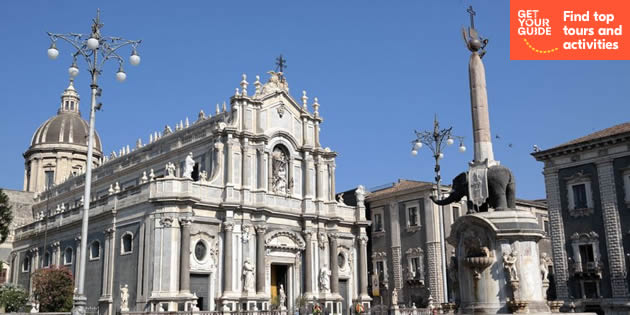
City Highlights Walking Tour
Enjoy a stroll in Catania city center with a professional tour guide and see the city through the eyes of a local.
Piazza Duomo in Catania represents the baroque heart of the city, now a UNESCO World Heritage Site. Inside it houses the Cathedral of Sant’Agata and the Palazzo dei Clierici, both joined by the Uzeda Gate. It also houses the Amenano Fountain, the Elephant Palace and the Elephant Fountain.
Cathedral of Sant'Agata stands on the site of the Roman Achillian Baths and the martyrdom of Sant'Agata, Patron Saint of city. The current church was built in 1711, based on a design by Girolamo Palazzotto following the terrible earthquake of 1693 during which it was completely destroyed.
Chierici Palace , once a symbol of the temporal power of the Church, was built after the earthquake of 1693 by the architect Alonzo Di Benedetto and enlarged in 1757 by Francesco Battaglia on a previous sixteenth-century structure: the Uzeda door, which connects the Palace to the Cathedral of Sant'Agata, represents what is left of the fortified walls made erected by Charles V. The distinctive feature of the Palazzo dei Chierici, also known as the Seminary of the Clerics, is the integration of the palace to the city walls. From the stairs to the right of the building you reach the Porta Carlo V, where the local market, the fish market, takes place.The eighteenth-century architecture takes up the typical contrast between the dark plaster and the white stone cornice, the windows and balconies have a characteristic omega tympanum between curled scrolls, figured shelves and the large tribune, as required by the Baroque style. Over time, many illustrious historical figures have appeared from the central balcony, including Cardinal Dusmet in 1888 to bless the city. In 1937 Mussolini spoke from it to the citizens during his visit to Catania.
The Uzeda Gate connects the two wings of the ancient seminary of the Clerics, the current seat of the Diocesan Museum and the Chierici Palace, and was built in 1695 by the Duke of Camastra and dedicated to the Viceroy in charge, Paceco de Uzeda, who had promoted the reconstruction of the city after the earthquake of 1693. Considered one of the symbols of the city, Uzeda Gate is built in typical Catania Baroque style, of which the typical alternation of lava stone and white marble for the decorations is characteristic, stylistically similar to the nearby Chierici Palace. Uzeda Gate opens towards the sea within the ancient sixteenth-century walls dedicated to the Spanish sovereign Charles V, and is part of the "new" defensive gates of Catania built after the lava flow of 1669 and the earthquake of 1693. From the overpass that connects it to the Diocesan Museum to the east, and to the Palazzo dei Chierici to the west, it is possible to enjoy a suggestive panorama that reveals the Baroque city and Mount Etna, on one side, and the arches of the Marina and the sea on the other. Passing through the door it is possible to admire a representation of Christ crowned with thorns. This representation, which was hit in the allied bombing, splintered only on one point on the forehead. The Gate is also linked to the highly anticipated feast of the Patroness of the Etna city, Sant'Agata. After the Mass of the Dawn, on February 4th, the fercolo crosses it, between clapping and waving of white handkerchiefs, to begin the procession of the Holy Relics of the Saint.
The Fontana dell'Amenano was built in 1867 by the Neapolitan Tito Angelini in white Carrara marble. The name of the fountain derives from the famous Amenano River, which in the fountain he is represented according to the canons of Greek mythology: a young man holding a cornucopia in his arms from which water emerges. The fountain is called the water fountain "a linzolu" by the people of Catania. The jet, in fact, is conveyed towards the tub and the water overflows from the shell-shaped tub, creating a particular cascade effect: the appearance resembles that of a draped sheet. The water then descends into the basins of the open duct of the underground river below. The fountain is one of the few places in Catania where the passage of the Amenano river is still visible, buried following the eruption and the lava flow of 1669. The Fontana dell? Amenano stands in a somewhat secluded position, but the structure it has been studied with great care, to create particular optical effects. The basin and the marble statue, in fact, seem to be embedded in the building behind them. medieval destroyed by the earthquake of 1693. The building has a quadrangular shape and has an entrance hall on each façade. The architect Vaccarini in 1732 revolutionized the façade by introducing the central balcony supported by four granite pillars, the focal point of the building, from which the Catanese authorities use to look out during the feast of Sant'Agata, he also adorned the pediments of the balconies with the letter "A", initial of the name of the Saint, and with sculpted elephants from which the name of the Palace derives.The opposite façade, which overlooks Piazza Università, built by Carmelo Battaglia in 1780, was severely damaged by a fire in 1944, caused by a popular uprising. On that occasion, the historical archive of the Municipality and the Risorgimento Museum were completely destroyed. In the central courtyard are exhibited the Senate carriages, dating back to the 18th century, which parade every year on the morning of February 3, during the Agatine celebrations. The works of art, paintings and frescoes kept in the reception rooms and in the Sala of the Palazzo Council are also of high value.
The Elephant Fountain , or also fountain of Liotru whose name is linked to legendary magician Eliodoro , was built by the architect Gianbattista Vaccarini in 1757 who used some historical relics of the city; as a symbol of the rebirth after the eruption and the earthquake, respectively of 1669 and 1693. On top of the fountain he placed "U 'Liotru", a statue of an elephant in lava stone from the Roman period to which he added the eyes in white stone and the fangs. The origin of the elephant statue & nbsp; is shrouded in stories and legends. The elephant supports on its back an Egyptian obelisk probably brought to Catania during the crusades by Syene. On the base are carved some cherubs and two bas-reliefs representing the two rivers of the city, the Simeto and the Amenano.
